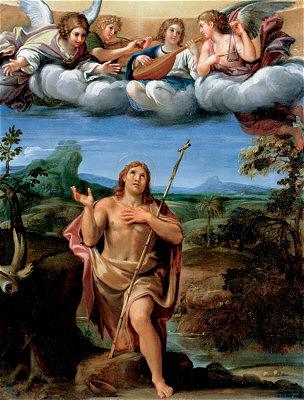ST JOHN THE BAPTIST IN THE
WILDERNESS
Francesco Albani
Italian, 1578-1660
SN 115, oil on copper, c. 1600 - 1606
From "The Pages".
ARTIST:
Francesco Albani was born in Bologna. While still a teen-ager he joined the Carracci
Academy, where life drawing and theoretical discussions formed the core of his education.
Taught by Annibale Carracci, he absorbed the ideas of early Baroque classicism and
integrated that style into his art.
He worked with Annibale (to whom this painting was originally attributed) as chief
assistant on several palace commissions, most notably the Palazzo Farnese. He painted
numerous cabinet pictures on religious and mythologic subjects, in addition to both
large-scale altarpieces and easel painting. His clients consisted of a growing number of
wealthy patrons, including King Louis XIV of France.
In 1618 he opened a studio in Bologna which functioned as both a school for artists and a
workshop for his own master designs. He is noted for his paintings of children. It is
rumored that he used his own 12 children as models for cherubs and Cupids, supposedly
suspending them from the ceiling with ropes in the process! |
|
 |
SUBJECT:
St John the Baptist was born in Jerusalem, cousin of Jesus. His mother, St Elizabeth, was
a barren older woman at the time the Archangel Gabriel told her that she would conceive.
When King Herod decreed death to all newborns, Elizabeth fled with her son into the
wilderness. There John remained, eating locusts and honeysuckle, and growing into a Holy
Man. When the Holy cousins finally met, John baptized Jesus. St John was beheaded for
denouncing King Herod’s incestuous union with Herodias. (See Preti’s Herodias
With the Head of John the Baptist, also in this gallery.)
PAINTING:
Research has affirmed that Albani drew his inspiration for this piece from a work by his
mentor, Annibale Carracci, whose own St John in the Wilderness shows the prophet in a
similar pose.
We see a young, muscular John kneeling with classical grace and calm; the frontality is
that of a Greek statue. One foot almost juts out of the picture plane. His eyes are turned
upward toward four music-making angels resting on clouds over his head. The clouds
horizontally divide the work into two separate sections – perhaps sacrificing visual
unity.
The assemblage of angels and the figure of John fill up the foreground, reducing the
importance of the landscape beyond. Have the angels come to reveal to him his mission to
preach baptism as a remission of sin? John has climbed to the pinnacle of the mountain,
his hermit’s staff (with cross on top) points heavenward. A small bowl rests at his
feet. It might symbolize the chalice…or may simply be the utensil he used in the
wilderness. In any case, John appears well-fed and content.
Below, a river wends its way from fore- to middle-ground which may allude to the River
Jordan, future site of John’s many baptisms. His halo is clearly delineated, which is
not entirely in keeping with the ideals of naturalism proposed by the Carracci. Overall
the painting exudes an aura of calm piety. Its small size and the popularity of the
subject suggest it was a cabinet painting displayed in a wealthy patron’s home.
Museum Label:
Saint John the Baptist in the Wilderness
c. 1600/1606
Artist: Francesco Albani
Italian, 1578-1660, active in Bologna, Mantua, and Rome
Oil on copper, 19 3/8 x 14 5/8 in. (49.2 x 37.1 cm)
Bequest of John Ringling, 1936, SN115
ringlingdocents.org
|